

This short analysis compares the precision of a Garmin etrex Vista and a Garmin etrex Vista HCx under different conditions. The "H" in the name of the HCx stands for "high sensitivity" and this receiver includes a newer generation of chipsets, so it's expected that the accuracy is better than the older Vista unit. Certainly the HCx can get a signal indoors when the Vista cannot receive any signals at all. This analysis intends to put some numbers behind those empirical findings.
Firstly both units were set to record tracks in a stationary position with good sky visibility. Then the units were taken to a location directly next to a tall and wide building, obscuring practically half the sky. Then we can see the effect of the limited visibility on both units.
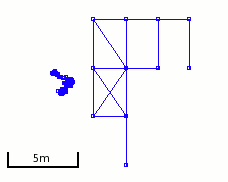 Screenshot of tracks from both units, HCx on left, Vista on right |
The units were set to simultaneously record track points at 15 second intervals, and placed side-by-side with good visibility of the sky. 135 points were obtained from each unit and loaded into Prune for visualisation. The screenshot from Prune, together with a rough scale from openstreetmap, are shown to the right. The denser track to the left is from the HCx, and the grid of points is from the Vista.
The most obvious difference seen in these tracks is the discretisation of the Vista points, where only certain floating point values are possible. At first this was thought to be an error in the reading or conversion of these points, but even after setting the receiver's units to degrees and downloading with gpsbabel and garble, the same quantisation exists. It appears that either the points are stored in the unit with this resolution, or the API for retrieving the points introduces this effect. In contrast, the HCx points have much finer granularity.
Secondly, the distribution of the HCx points is much denser than the Vista points, with much less variation between readings. Even though both units had a large number of satellites visible (which is sadly not recorded in the track data), the variation in the HCx points is much smaller.
Thirdly, the mean position recorded by the units is clearly different. The difference between the values is only small (approximately 3 metres), but it is real. It is possible that with a longer recording interval this difference would become even smaller.
Having calculated the mean position as recorded over the time interval, we now compare each point with this mean and calculate the root mean square distance. Surprisingly for the HCx this number turns out to be a very small 0.3 metres, however this doesn't give the accuracy of the device, just the stability of the readings within our (relatively short) time interval. For the Vista we can do the same calculation for the same number of points and same time interval, getting an rms distance of 2.1 metres, which is significantly greater than that for the HCx. No doubt part of this is due to the discretisation but the variation in position readings is also definitely higher for the older unit. This is perhaps surprising as under good conditions one would expect both units to be able to get sufficient signal quality for a similar quality of coordinate reading.
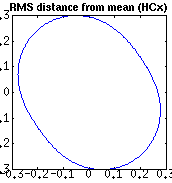
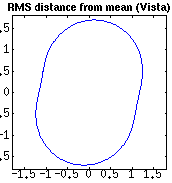
We can also plot the anisotropy of these distances, to examine whether the errors are equally distributed by angle. The results are shown here for the two receivers.
Although these diagrams are not exactly circular, they do indicate that the error distributions are roughly symmetric, with only small differences between the longitude and latitude errors. This corresponds to what we might expect from good reception conditions and a symmetric distribution of visible satellites.
Note also that the scales on these graphs are not equal - the HCx scale is 0.3m and the Vista scale is 1.8m.
Now both receivers are moved to a nearby point at the base of a substantial building. Thus only half the sky is visible and about half is obscured. One might expect that the more sensitive receiver might cope better with the sight reduction, being able to obtain signals from satellites which are now undetectable by the older unit. But both receivers now have poor geometry to resolve the coordinates in one direction, so one would expect that the error distributions are no longer symmetric.
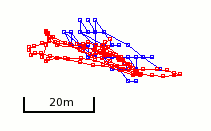 Screenshot of tracks from both units, HCx in red, Vista in blue |
Here, the tracks overlap much more than before, and the difference between the mean points is only 0.1m instead of 3m. But as can clearly be seen in the screenshot, the variation in the measured coordinates is much greater than before, and is notably non-symmetric.
As before, we can calculate the root mean square distance from the mean. For the HCx this was 6.9m, a great increase from the 0.3 metres measured earlier. But the big surprise was the rms distance for the Vista, measured this time at only 6.1m. Even though this is also much more than the value measured under good conditions, the surprise is that it is actually lower than the HCx.
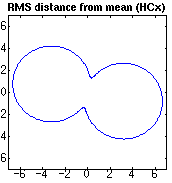
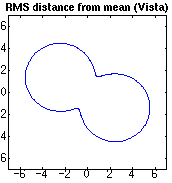
Again we can plot the anisotropy of these distances, to examine whether the errors are equally distributed by angle. The results are shown here for the two receivers.
Obviously the scales are much bigger for these two diagrams, showing the greater measurement variation, but also it can clearly be seen that the distribution of coordinates is no longer symmetric, or even nearly symmetric. There is a strong tendency for the points to be spread along a line rather than distributed in all directions about the centre.
We can easily calculate the angle of greatest spread, which is slightly different for the two receivers. For the HCx, the greatest spread occurs at 14° clockwise from the horizontal, whereas for the Vista it occurs at 29°. We can explain this by the asymmetry of the building, which we would expect to introduce a larger uncertainty in position in an axis perpendicular to its facade.
Looking at a satellite photo of the building in question on Google Earth, we can estimate the bearing of the building facade to be around 31° from North, which makes a line perpendicular to this facade to be around 31° clockwise from the horizontal. This agrees quite well with the Vista data, confirming that this asymmetry is producing the effect we expected. The distribution of the point data is much more pronounced in a direction perpendicular to the obstruction because the geometry in this direction is less favourable. In the direction parallel to the obstruction, the geometry is still good so the uncertainty in this direction is smaller.
It's currently not clear why the HCx data exhibits a higher variance, or why the angle doesn't agree with the building angle quite as well as the Vista. It's possible that the data size is too small (because the observation period is too short) or that small differences in the receiver position affected the shadowing and hence the data reception.
It has been shown that under good conditions the newer, HCx receiver does show a much more stable measurement set than the Vista. It also does not suffer from the same quantisation that the Vista data has. We can also see that an asymmetric sky obstruction strongly affects the measurements, and in a way which corresponds to the geometry of the obstruction.
There are still some question marks about the HCx performance with this obstruction, which might benefit from a longer and/or more careful observation. One suggestion is that the building is not only obstructing signals but also reflecting them, and it's possible that the HCx is more affected by these reflections than the less sensitive receiver.